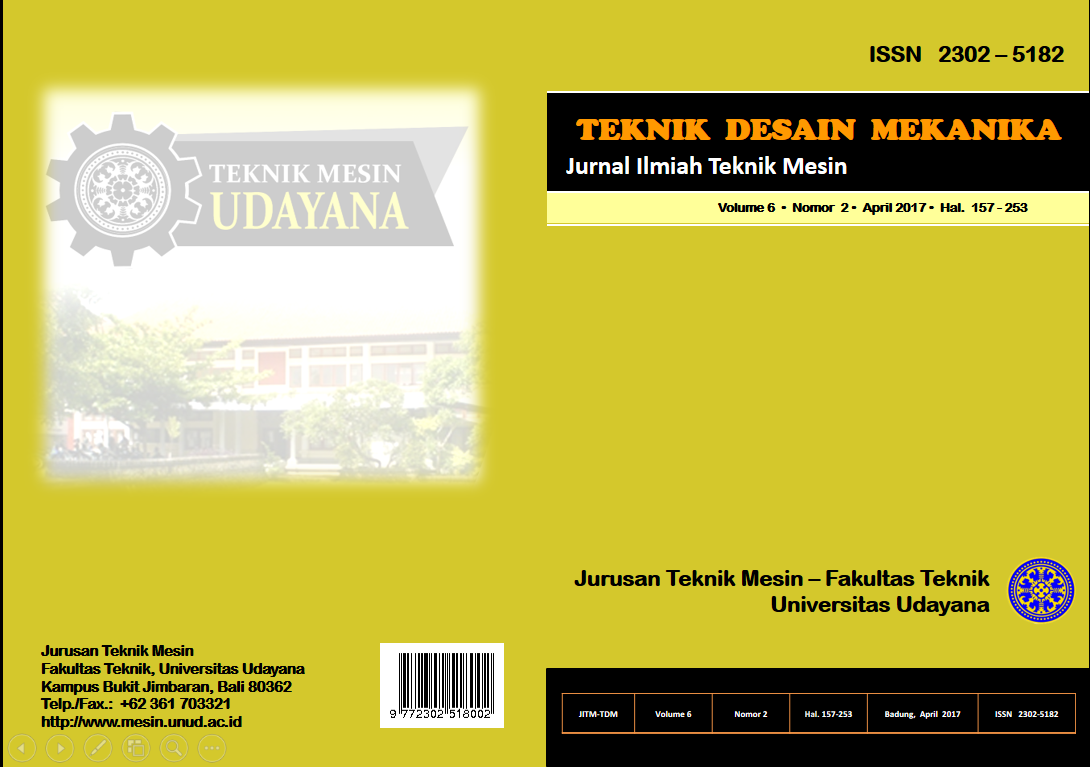Studi Eksperimental Pengaruh Variasi Tekanan Terhadap Sudut Semburan Minyak Jelantah
Abstrak
Abstrak
Energi terbarukan dari minyak nabati salah satunya adalah minyak jelantah, yang mampu memberikan solusi krisis energi
pada masa depan. Minyak jelantah yang digunakan secara teknis telah memenuhi syarat dijadikan sebagai bahan bakar
nabati, namun demikian kekentalan, kerapatan serta kadar asam lemak bebas yang tinggi, dan kendala senyawa pengotor
yang masih tinggi maka sulit teratomisasi pada saat digunakan. Minyak jelantah sebelum diinjeksikan pada nosel
penyemprotan bahan bakar perlu mendapatkan perlakuan, maka dari itu Penelitian ini menguji penyemprotan bahan bakar
minyak jelantah dengan pemanasan awal dan memberikan variasi tekanan injeksi pada nosel.Tujuan penelitian ini adalah
untuk mengetahui perubahan karakteristik semburan minyak jelantah pada ujung nosel, dengan pemberian variasi tekanan.
Peralatan yang digunakan pada penelitian adalah: kompresor, pressure regulator, tangki bahan bakar, pressure gauge,
pipa line, pipa lilitan, heater, keran, nosel, thermocouple, data loger, kamera dan layar warna hitam. Penelitian dilakukan
dengan cara memanaskan minyak jelantah pada pipa lilitan dengan menggunakan heater sampai temperatur 350oC,
selanjutnya diberikan tekanan 3, 4, dan 5 bar serta nosel yang digunakan berukuran 0.5 mm, sehingga minyak jelantah yang
sudah diberikan pemanasan keluar pada ujung nosel akan membentuk sudut semburan.Hasil pengujian yang dilakukan
mengenai pengaruh tekanan terhadap sudut semburan minyak jelantah diperoleh bahwa, variasi tekanan yang diberikan
berpengaruh terhadap sudut semburan minyak jelantah. Peningkatan tekanan dari 3 bar, 4 bar dan 5 bar, menyebabkan
peningkatan sudut semburan pada ujung nosel.
Kata Kunci: Minyak Jelantah, Nosel, Sudut Semburan.
Abstract
Renewable energy from vegetable oil is waste cooking oil, which can provide a solution to the energy crisis in the future.
The waste cooking oil that is technically qualified is biofuel; however, its viscosity, density and free fatty acid level are high,
and its impurity compound is difficult to be atomized at the time of use. The waste cooking oil which is injected in the nozzle
spraying fuel needs treatment; therefore, this study tests the fuel of spraying cooking oil with preheating and provides
injection of pressure variations at the nozzle.The purpose of this study was to determine the change of the spraying
characteristic of the waste cooking oil on the tip of the nozzle with the provision of pressure. The equipment used in the
research includes compressor, pressure regulator, fuel tank, pressure gauge, pipe line, pipe coil, heater, valve, nozzle,
thermocouple, data logger, camera and display color black. The study was conducted by heating the cooking oil in the pipe
coil using a heater at a temperature of 350oC, then pressure 3, 4, and 5 bar the nozzle which is 0.5 mm in size is used, so
that the waste cooking oil that has been heated at the end of the nozzle will form an sprayingangle. The result of the test
shows that varied pressures affects the sprayingangle of the waste cooking oil. The increased pressure of 3 bar, 4 bar and
5bar causes the sprayingangle to increase. The diameter of the nozzle rises from 0.4 mm to 0.6 mm at a pressure of 3 bar
and 4 bar; however, different things happens at a pressure of 5 bar with a nozzle 0.6 mm,causingthe spraying angleon the
tip of the nozzle to rise.
Keywords: Waste Cooking Oil, Nozzle, Spray Angle.


